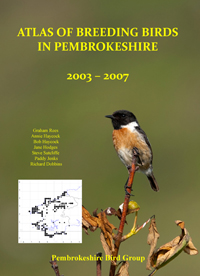Podiceps cristatus
Most Great Crested Grebes have been noted on salt water, with Angle Bay and Fishguard Harbour holding the largest concentrations, maximum annual counts being :
Angle Bay

Fishguard Harbour

Other wintering locations were Newport Bay, St Bride’s Bay, Amroth / Saundersfoot and the higher reaches of the Cleddau Estuary.
Occasional sightings have come from the Teifi Estuary and all around the outer coast, including the offshore islands of Skokholm and Skomer and passing Strumble Head. Presumably these birds were either through migrants or in transit to the regular wintering localities.
References
DONOVAN. J and REES. G. 1994. Birds of Pembrokeshire, Dyfed Wildlife Trust.
LOCKLEY. R. M, INGRAM. C. S. and SALMON. H. M.1949. The birds of Pembrokeshire, West Wales Field Society.
MATHEW. M. 1894. The birds of Pembrokeshire and its islands, R. H. Porter.
 Monday, September 16, 2013 at 8:02AM
Monday, September 16, 2013 at 8:02AM 





